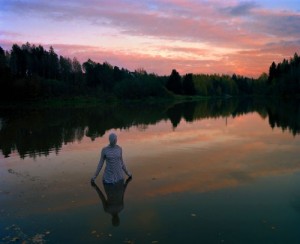Carrie Schneider arrived in Helsinki, Finland already feeling an an intrinsic, intuitive connection with artists from the region. Her one-year Fulbright fellowship (2007-2008) at theFinnish Academy of Fine Arts only intensified her affinity to the style of Finnish women artists, which might be described as emotionally resonant yet visually sparse.
Schneider’s experience in Finland not only provided opportunities for dialogue with local artists, but also offered a release from the intense pressures presented by graduate school; she received her MFA from the School of the Art Institute in 2007.
“I was obsessed with the work of Finnish artist Salla Tykkä,” says Schneider. “When I was in graduate school, I was part of a visiting artist community that invited her to speak at the Art Institute of Chicago, and do public lectures and studio visits. I got to know her really well, and when I was in Helsinki, I got to work with her as one of my advisors on the Fulbright project.”
Schneider also had an opportunity to learn from Finnish filmmaker Eija Liisa-Ahtila, another artist she greatly admired.
Schneider is a master at capturing heightened emotional moments. This ability appears in one of her most recent bodies of work entitled Reading Women (2012) in which she documents her female friends—mostly writers, artists, and musicians—completely engrossed in a text. Schneider invites friends to read in her home for about two hours; she watches them in a curious, yet non-voyeuristic way, and snaps the photograph in the moment of complete immersion—when the subject is lost in the book.
“What initially compelled me to begin the project is mirrored in the portraits themselves: a young artist’s desire to connect with another creative voice in a way that resonates with her own art and life,” Schneider told Jessie Wender of the New Yorker.
Schneider’s fascination with building an art practice about intense psychological experiences, which are essentially agreements between two subjects or the subject and the artist, are very much rooted in the Finnish artists with whom she worked during her Fulbright fellowship.
“There’s this tendency toward extreme formality [in the work of Finnish artists I worked with], which could seem very cold or distancing. But there’s also something really psychologically hot in there, borderline psychedelic, because there’s this extremeness that they call ‘sisu,’ like this internal strength,” she explains. “There’s this formality that can seem sort of stilted. There’s something about it that’s unnatural and then there’s something intense and crazy. That’s what I was attracted to in Eija Lisa-Ahtila, Liisa Roberts, and Sala Tykkä.”
Read the full story on Art21: http://blog.art21.org/2013/02/22/carrie-schneider-adds-a-finnish-touch/




